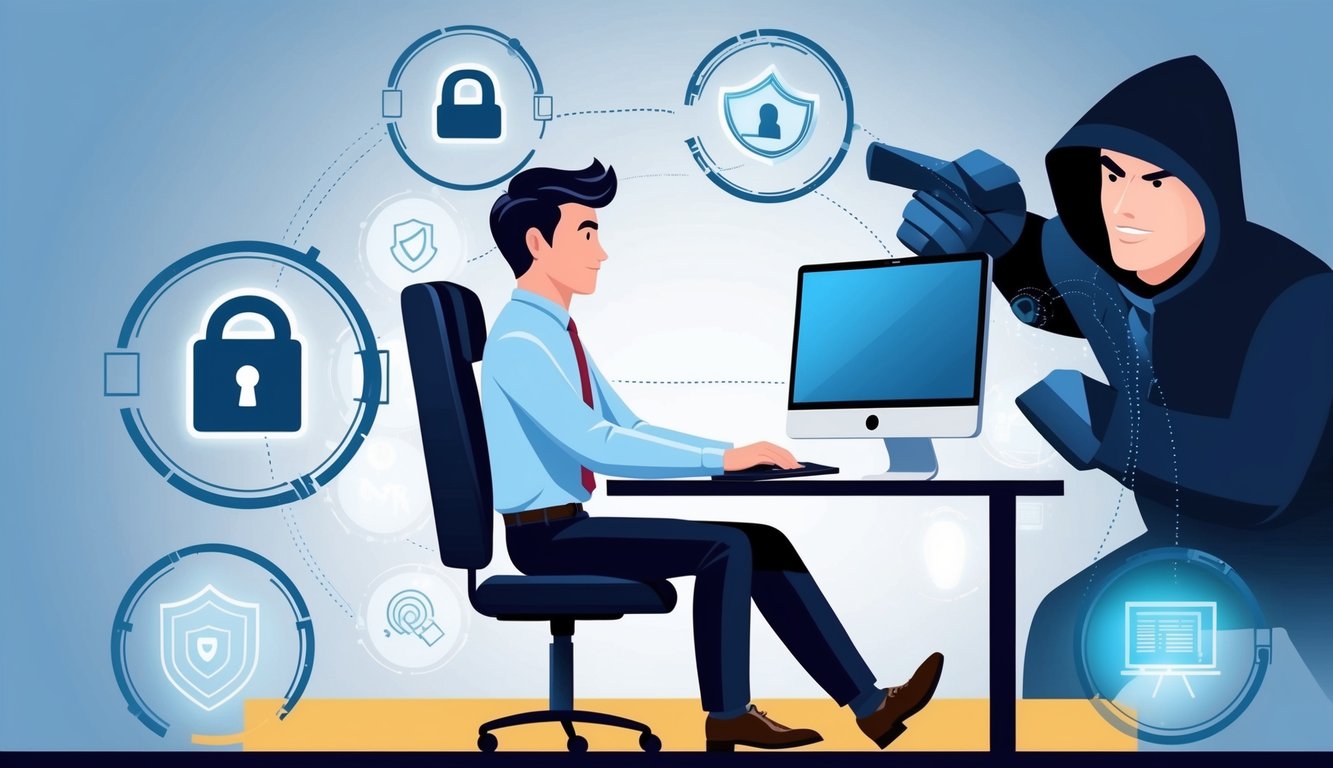Navigating the Information Minefield
In today’s digital landscape, local businesses face constant cybersecurity threats. Distinguishing between reliable advice and misleading information is crucial for protecting sensitive data and maintaining customer trust. Local companies can effectively allocate resources and implement robust security measures by separating fact from fiction when seeking cybersecurity guidance.
Misinformation about cybersecurity abounds, often leading small businesses to underestimate their vulnerability. Contrary to popular belief, small businesses are prime targets for cybercriminals who assume they lack strong security measures. Recognizing this reality is the first step toward building a comprehensive defense strategy.
To navigate the complex world of cybersecurity, you need to cultivate a critical mindset and seek information from reputable sources. By doing so, you’ll be better equipped to make informed decisions about your business’s digital security needs and avoid falling prey to common misconceptions that could leave you vulnerable to attacks.
Key Takeaways
- Prioritize separating cybersecurity facts from fiction to effectively protect your local business.
- Understand that small businesses are attractive targets for cybercriminals
- Develop a comprehensive cybersecurity strategy based on accurate information and regular assessments
The Cybersecurity Landscape for Local Businesses
Local businesses face unique cybersecurity challenges in today’s digital world. You must navigate an ever-evolving threat landscape while often operating with limited resources.
Cybersecurity threats to local entities are becoming increasingly sophisticated. Ransomware attacks, phishing schemes, and data breaches pose significant risks to your operations and reputation.
You’re tasked with safeguarding sensitive customer information and proprietary data. This responsibility extends to protecting your digital infrastructure from malicious actors seeking to exploit vulnerabilities.
Key cybersecurity concerns for local businesses include:
- Inadequate security measures
- Lack of employee training
- Limited IT resources
- Outdated software and systems
- Insufficient data backup practices
Implementing cybersecurity best practices is crucial for your business’s longevity. This includes regular security assessments, employee education programs, and robust incident response plans.
The cybersecurity skills gap presents an additional challenge. You may struggle to find qualified personnel to manage your cybersecurity needs effectively.
Collaboration with local educational institutions and cybersecurity firms can help bridge this gap. These partnerships can provide access to expertise and resources that might otherwise be out of reach.
Remember, cybersecurity is not solely an IT issue. It requires a holistic approach involving all aspects of your business operations. You can better protect your local business from cyber threats by staying informed and proactive.
Identifying Common Cybersecurity Myths
As a local business owner, you must know prevalent cybersecurity myths that could leave your company vulnerable. Let’s examine some common misconceptions:
Myth 1: Small businesses aren’t targets for cyberattacks.
Reality: Cybercriminals often target small businesses because they may have weaker security measures. Your business is not too small to be noticed by hackers.
Myth 2: Strong passwords are enough to protect accounts.
Truth: While important, strong passwords alone are insufficient. For better security, you should implement multi-factor authentication and regular password updates.
Myth 3: Cybersecurity is solely an IT issue.
Fact: Cybersecurity concerns your entire organization. It involves HR, legal teams, and executive leadership. Integrate security practices into your company culture.
Myth 4: 100% cybersecurity is achievable.
Reality: Perfect security is a myth. Cybersecurity is an ongoing process, not a one-time fix. You must continuously update and improve your defenses.
Myth 5: Antivirus software provides complete protection.
Truth: Antivirus software is just one component of a comprehensive security strategy. For robust protection, you need firewalls, encryption, employee training, and regular system updates.
By recognizing these myths, you can make more informed decisions about your business’s cybersecurity measures. Stay vigilant and seek expert advice to protect your digital assets effectively.
Strategies for Separating Fact from Fiction
To effectively separate fact from fiction when seeking cybersecurity advice, you must develop a critical mindset and employ specific strategies. Start by verifying the credibility of your sources. Look for reputable industry publications, certified experts, and established cybersecurity firms.
Cross-reference information from multiple sources to identify consistencies and discrepancies. Be wary of claims that seem too good to be true or contradict widely accepted industry standards.
Consider the context and potential biases of the information you encounter. Ask yourself:
- Who is providing this advice?
- What are their qualifications?
- Do they have any hidden agendas or conflicts of interest?
Stay up-to-date with the latest cybersecurity trends and threats. This knowledge will help you better evaluate the relevance and accuracy of the advice you receive.
Don’t hesitate to seek second opinions from trusted professionals. Consult with experienced cybersecurity experts who can advise you on your business needs.
Remember that cybersecurity is an evolving field. What was considered best practice yesterday might not be sufficient today. Regularly reassess your strategies and adapt to new threats and technologies.
By applying these strategies, you’ll be better equipped to distinguish between reliable cybersecurity advice and misleading information.
Building a Foundation of Cybersecurity Knowledge
Local businesses need a solid understanding of cybersecurity basics and reliable information sources to protect themselves effectively. This knowledge empowers you to make informed decisions and implement appropriate security measures.
Understanding Basic Cybersecurity Terminology
To navigate the complex landscape, familiarize yourself with crucial cybersecurity terms. Cybersecurity culture is a critical concept emphasizing ongoing vigilance and proactive protection.
Common terms you should know include:
- Malware: Software designed to harm or exploit systems
- Phishing: Fraudulent attempts to obtain sensitive information
- Firewall: A network security system that monitors traffic
- Encryption: Encoding data to prevent unauthorized access
Understanding these terms helps you communicate effectively with IT professionals and make informed security decisions. Stay updated on evolving terminology as cybersecurity threats constantly change.
Recognizing Trustworthy Sources of Information
Identifying reliable cybersecurity information is crucial for your business’s protection. To avoid misinformation, seek guidance from reputable organizations and industry experts.
Trusted sources include:
- Government agencies (e.g., CISA, NIST)
- Professional associations (e.g., ISACA, (ISC)²)
- Cybersecurity firms with established track records
- Academic institutions with cybersecurity programs
Verify information across multiple sources before implementing any security measures. Be cautious of unsolicited advice or miraculous solutions that seem too good to be true.
Assessing the Threat Landscape
Small businesses face unique cybersecurity challenges in today’s digital landscape. Understanding the risks and legal requirements is crucial for protecting sensitive data and maintaining customer trust.
Evaluating Risk for Small Businesses
You need to identify your specific vulnerabilities as a small business. Conduct a cybersecurity risk assessment to uncover potential threats to your systems and data.
Inventory your digital assets, including hardware, software, and data repositories. Analyze each for weaknesses that attackers could exploit.
Consider your industry and business model. Specific sectors, like healthcare or finance, may be more attractive targets due to the sensitive data they handle.
Assess your current security measures. Are your firewalls, antivirus programs, and access controls up to date? Do you have a plan for responding to potential breaches?
Don’t overlook insider threats. Ensure your employees are trained in cybersecurity best practices and that you have protocols in place to manage access to sensitive information.
The Importance of Data Protection Laws
You must be aware of and comply with relevant data protection regulations. These laws aim to safeguard personal information and can carry significant penalties for non-compliance.
Familiarize yourself with laws applicable to your business, such as GDPR for European customers or CCPA for California residents. These regulations often require:
- Transparent data collection and usage policies
- Secure storage and transmission of personal information
- Prompt notification of data breaches
- User rights to access, correct, or delete their data
Implement privacy controls that align with these requirements. This may include encrypting sensitive data, conducting regular security audits, and appointing a data protection officer.
Stay informed about changes in data protection laws. The regulatory landscape is evolving, and new requirements may affect your business operations.

Developing a Cybersecurity Plan
A well-crafted cybersecurity plan is crucial for protecting your local business from digital threats. It involves identifying critical assets, implementing robust security policies, and ensuring your employees are well-versed in cybersecurity practices.
Identifying Key Cybersecurity Assets
Start by cataloging your digital assets, including hardware, software, and data. Prioritize these assets based on their importance to your business operations and potential impact if compromised.
Consider the following:
- Customer data
- Financial information
- Intellectual property
- Employee records
Assess the vulnerabilities of each asset. This might involve conducting regular security audits or penetration testing.
Create an inventory system to track these assets, including their location, purpose, and access permissions. This will help you maintain an up-to-date view of your digital landscape and quickly identify any unauthorized changes or access.
Implementing Effective Security Policies
Develop clear and comprehensive security policies tailored to your business needs. These policies should cover various aspects of cybersecurity, from password management to data handling procedures.
Key elements to include:
- Access control measures
- Data encryption standards
- Incident response procedures
- Remote work security guidelines
Regularly review and update these policies to address new threats and technologies. Ensure that your policies are easily accessible to all employees and clearly define roles and responsibilities for maintaining security.
Consider implementing multi-factor authentication for all critical systems and applications. This adds an extra layer of protection against unauthorized access.
Educating Employees on Cybersecurity Practices
Your employees are often the first line of defense against cyber threats. Develop a comprehensive training program to educate them on cybersecurity best practices and your company’s policies.
Key training topics should include:
- Recognizing phishing attempts
- Proper password management
- Safe browsing habits
- Data handling procedures
Conduct regular training sessions and provide ongoing updates about new threats. Consider using simulated phishing exercises to test and reinforce employee awareness.
Encourage cybersecurity awareness by rewarding employees who report suspicious activities or potential security breaches. This proactive approach can help prevent incidents before they occur.
Conducting Regular Cybersecurity Audits
Regular cybersecurity audits are crucial for local businesses to protect their digital assets. These audits help you verify compliance with cybersecurity standards and identify potential vulnerabilities in your systems.
You can stay ahead of emerging threats and strengthen your security posture by conducting audits. Cybersecurity audits typically involve six steps:
- Planning and scoping
- Information gathering
- Vulnerability assessment
- Risk analysis
- Reporting
- Follow-up and remediation
Regular audits offer several benefits for your business:
- Ensure compliance with industry regulations
- Identify and address security gaps
- Improve incident response capabilities
- Enhance customer trust and confidence
To get the most out of your audits, consider working with experienced cybersecurity professionals. They can provide valuable insights and help you implement best practices tailored to your business needs.
Remember, cyberattacks are on the rise, with an average of 1,308 attacks per organization weekly in early 2024. By conducting regular audits, you can significantly reduce your risk of being harmed by these threats.
Make cybersecurity audits a priority in your business operations. They are essential for separating fact from fiction and ensuring your digital assets remain secure in an increasingly complex threat landscape.
The Role of Professional Cybersecurity Services
Professional cybersecurity services are crucial in protecting your local business from digital threats. These experts can help implement essential cybersecurity practices tailored to your specific needs.
When you engage in professional services, you gain access to the following:
- Up-to-date threat intelligence
- Customized security solutions
- Ongoing monitoring and support
These specialists can assess your security posture and identify vulnerabilities you may have overlooked. Their wealth of experience working with various organizations allows them to spot potential risks quickly.
Professional services can also help you integrate cybersecurity into your business operations. This integration ensures that security becomes a part of your company culture rather than an afterthought.
By leveraging professional services, you can focus on your core business activities while experts handle the complex world of cybersecurity. This approach can save you time and resources in the long run.
Remember, cybersecurity is not just an IT issue. It’s a business imperative that requires ongoing attention and expertise. Professional services can provide the guidance and support you need to navigate this critical aspect of modern business operations.
Investing in Continuous Cybersecurity Training
You can’t afford to neglect ongoing cybersecurity training for your local business. The digital landscape evolves rapidly, and so do the threats you face. Regular training keeps your team alert and prepared.
Continuous cybersecurity training is crucial for comprehensive protection. Relying solely on tools from Managed IT Services providers isn’t enough. Your employees are your first line of defense.
Effective training programs should include:
- Regular phishing simulations
- Updates on emerging threats
- Best practices for password management
- Data handling protocols
Investing in training can yield significant returns. Companies that prioritize employee training are better equipped to prevent costly breaches.
Consider conducting pre-and post-training assessments to measure the effectiveness of your program. This approach helps you identify knowledge gaps and track improvement over time.
Remember, cybersecurity isn’t just about technology. It’s about human behavior. By investing in your team’s knowledge, you’re strengthening your entire security posture.
Make cybersecurity training an ongoing priority. Schedule regular sessions throughout the year to ensure your employees are aware of security. This consistent approach will help embed good practices into your company culture.
Adopting a Proactive Stance on Cybersecurity
As a local business owner, you must shift your cybersecurity approach from reactive to proactive. This change is crucial for protecting your valuable data and maintaining customer trust.
Proactive cybersecurity strategies are essential for staying ahead of attackers. By implementing these measures, you can identify and address vulnerabilities before they are exploited.
Key elements of a proactive cybersecurity stance include:
- Continuous monitoring of your systems
- Regular security assessments
- Employee training programs
- Implementation of advanced technologies
Contrary to common belief, proactive cybersecurity isn’t necessarily expensive or time-consuming. While there may be initial costs, they pale compared to a cyber breach’s potential financial and reputational damage.
You should view cybersecurity as a critical business imperative, not just a technical problem. This perspective shift allows you to integrate security measures into all business operations.
Adopting a proactive stance creates a robust defense strategy that protects your business and customer data. This approach enhances your security and demonstrates your commitment to safeguarding sensitive information.
Conclusion
Separating fact from fiction in cybersecurity is crucial for local businesses. You can make informed decisions to protect your company by dispelling common myths.
Remember that cybersecurity is not just an IT issue. It requires involvement from all departments and should be integrated into your organization’s culture.
Stay vigilant and up-to-date with the latest threats and best practices. Cybercriminals constantly evolve their tactics, so your defenses must adapt, too.
Invest in employee training and awareness programs. Properly educated staff can be your most vigorous defense against cyber attacks.
Don’t fall into thinking small businesses are safe from attacks. Cybercriminals target organizations of all sizes.
Assess your cybersecurity measures regularly and seek professional advice when needed. The digital landscape is complex, and expert guidance can be invaluable.
Separating fact from fiction empowers your local business to face cyber threats head-on. Stay informed, stay prepared, and prioritize your digital security.







